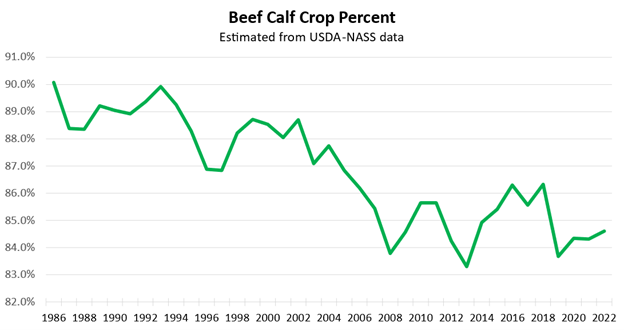Importance of Reproductive Efficiency

If beef production was perfect, all our cows and heifers would get pregnant in the first 21 days of breeding season, calve unassisted about 9 – 9 ½ months later and wean off a calf weighing 50% of their mature weight about 6 – 7 months after calving. Our cattle would be living in symbiosis with nature so that the cattle, the soil and the plants grazed in our production environment were all healthy, vigorous and productive. Cows highest nutritional requirements (at peak lactation) would occur when our forage was of the highest quality and post-weaning, our dry cows would be grazing our mature or dormant forage when they have their lowest nutritional requirements of the annual production cycle. The cows would seldom vary from a body condition scores (BCS) of 5.5 – 6.
The reality that beef production is not perfect and the “ideals” listed above are seldom achievable on a herd-wide basis, should never be considered an acceptable excuse to accept less than those standards. Selection, nutrition, herd health and parasite control, proper stocking rates and range management all impact the Percent Calf Crop Weaned. And while we manage according to what is practical and economically feasible, we need to remain steadfast and relentless in our pursuit of a 100% calf crop weaned and breeding females weaning off the highest possible percentage of their mature weight. Why? Because in cow-calf production systems, the source of the initial product in the beef production chain, few traits (if any) outweigh the economic importance of Percent Calf Crop Weaned. Breeding females that are open at the end of breeding season or fail to carry a pregnancy to term and produce a live calf, and calves that die between birth and weaning are a drain on the profit potential of any operation.
Data collected at weaning this fall should serve as an indicator of where management, nutrition, herd health or genetics could be improved. A defined (short, 90 days or less) breeding season, good records of female inventory at the beginning of the last breeding season, calving season and now at weaning can reveal information to help determine where and when incremental improvements can be gained. In the end we want to get as close to the “perfect” numbers we mentioned above, along the way, several calculations (covered in Chapter 4 of the OSU Beef Cattle Manual) can lead to more informed management decisions.
When evaluating the reproductive efficiency of your herd, keep the following in mind:
1) Under the best management and environmental conditions, 90% (or higher) Percent Calf Crop Weaned can be hard to achieve. Recently Dr. Derrell Peel put together the following graph:

1)-continued, Yes, the graph indicates that on a national basis the Percent Calf Crop Weaned has not improved over the past 37 years.
2) Genetics/Heterosis. Reproductive traits are low in heritability but show high levels of heterosis in response to crossbreeding. Although additive genetic influence doesn’t account for much of the variation in reproductive efficiency, there are several genetic values available to assist in bull selection to improve the reproductive performance of daughters sired. Selection pressure on EPDs for traits such as Heifer Pregnancy, Mature Weight, Milk, and Calving Ease Maternal can lead to improved genetic potential for reproductive efficiency.
3) Nutrition. Monitoring BCS of cows so that they are at 5.5 – 6 at the beginning of calving season shortens the rebreeding interval. Managing the calving season so that cows peak nutritional requirements coincide with peak forage quality and quantity is beneficial. Your forage resources should dictate the optimum mature cow size and level of milk production that fits your environment. Moderation of cow size and milk potential can pay dividends.
4) Herd Health and Parasite Control. Looking at the amount of females exposed that got bred, stayed bred and the amount of calves that survived from birth to weaning can often reveal if herd health protocols need improvement. Parasite control can pay dividends.
References: OSU Beef Cattle Manual, Eighth Edition, E-913; Dr. David Lalman; Dr. Derrell Peel







